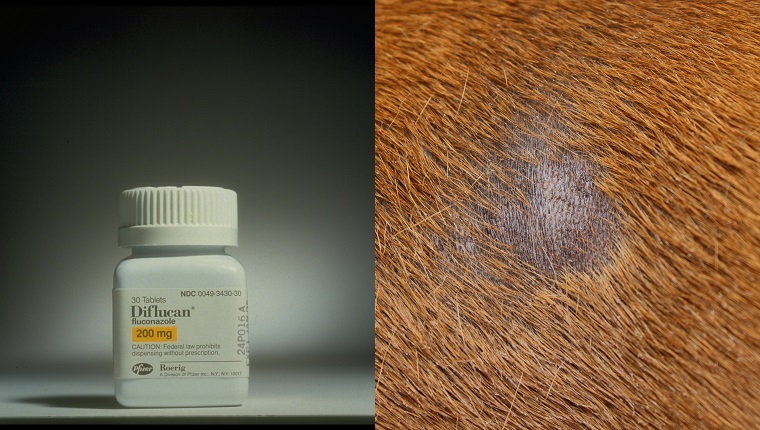Fluconazole is an anti-fungal medication often used to treat yeast fungal infections in dogs. Its most common use is to treat skin infections, but it can also treat fungal infections in organs or elsewhere in dogs’ bodies.
Though the FDA has not approved it for veterinary, the drug is available with the prescription of a veterinarian and often goes by the brand names Diflucan or Trican. If your vet prescribes it, it’s important that you strictly follow their instructions for administering it to your dog.
You can easily order fluconazole for your dog online from Chewy’s pharmacy with your vet’s prescription.
Here’s what you should know about the uses, dosage, and side effects of fluconazole in dogs.
Uses Of Fluconazole For Dogs

Fluconazole is most commonly used to treat skin infections in dogs, as well as infections of the nail beds. It’s often chosen for treatment when other anti-fungal medications fail, as fluconazole is effective at fighting off more serious infections and often has fewer side effects.
It can be used to treat ringworm, though vets often reserve the drug for infections that are more intense, such as Blastomycosis and Histoplasmosis.
Fluconazole is effective in treating infections in other areas of the body, as well. Vets sometimes use it to treat urinary infections or infections of the lungs and organs that may occur when dogs inhale fungus from infected soil.
Vets also often chose it above other medications to treat fungal infections of the central nervous system because the drug is able to cross the blood-brain barrier. This allows the medication to travel to where it’s needed more effectively.
Dosage Of Fluconazole For Dogs

The usual dosage of fluconazole for dogs varies widely depending on the condition being treated. The following is a guideline and must not replace your vet’s dosage advice for your individual dog.
A ve may prescribe between 5.5 mg and 22 mg per pound of a dog’s weight and may recommend administering it once every twelve to 24 hours. It comes in tablet form, and dogs should take it orally with or without food.
If your vet prescribes fluconazole for your dog, then you must stick to their instructions and continue giving your dog the medication for the full length of time that they prescribe.
The body absorbs the drug quickly, but you’re not likely to see symptoms improve for one to two weeks. It may take several months before the condition disappears entirely.
Side Effects Of Fluconazole In Dogs

Side effects of fluconazole in dogs haven’t been thoroughly studied, though several side effects have been observed in humans, and some similar effects have been seen in dogs.
Here are a few common side effects you may see in dogs who take fluconazole:
- Diarrhea
- Vomiting
- Loss of appetite
- Dark urine
- Jaundice
- Rash
- Fatigue
- Anemia
- Pale gums, tongue, or nose
- Renal failure
As with all medications, there is a risk of allergic reaction to fluconazole in dogs which may lead to anaphylaxis. If you see the signs of an allergic reaction, such as itchiness, hives, swelling, difficulty breathing, or other symptoms, contact your vet right away.
Should side effects become severe or cause you concern, consult your vet. They can then adjust the dosage or seek an alternative form of treatment.
Has your vet ever prescribed this medication for your dog? Was it effective? Let us know in the comments below!





